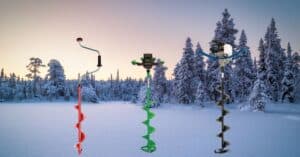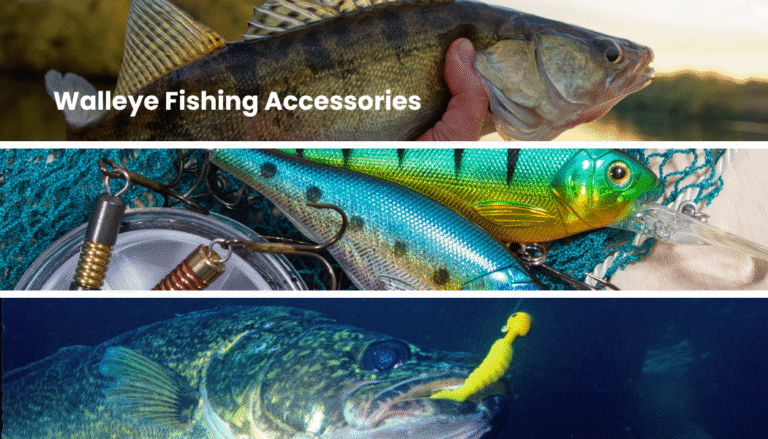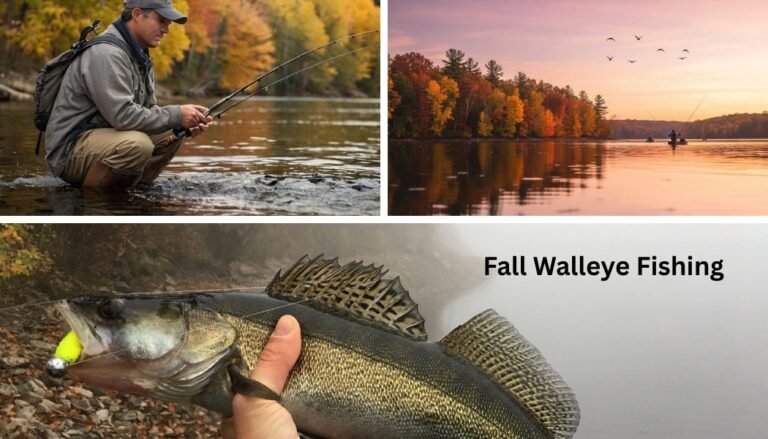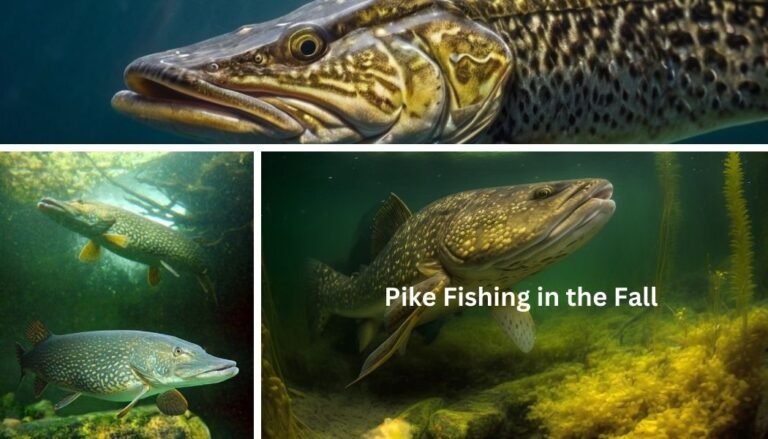Everything About Ice Fishing Augers
An ice fishing auger is a specialized tool that cuts through ice, creating holes for fishing, testing ice thickness, or other purposes on frozen water bodies. Modern ice augers come in various models, each designed to handle different ice thicknesses and power levels. Knowing the basics of each type can help you select the right auger for your fishing requirements.
Types of Ice Augers
Manual Ice Augers
Manual ice augers are ideal for lightweight and budget-friendly options. They rely solely on user strength, requiring more effort in thick ice, but work well for thin to moderately thick ice. They’re quieter than powered augers and offer a good workout, making them suitable for anglers who fish in areas where motorized equipment isn’t allowed. They are usually used for cutting 6 to 8-inch holes. The bigger the hole, the more effort is needed to cut that hole.

Electric Ice Augers
Electric augers are a modern option powered by rechargeable batteries, combining portability with easy operation. They offer a quieter alternative to gas-powered augers, ideal for environments where noise must be minimized. The battery life depends on factors like ice thickness, temperature, and auger size, making it necessary to carry backup batteries for extended trips.
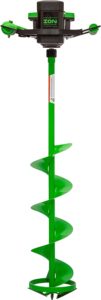
E-Drill Ice Augers
This is an auger that you attach to a battery-powered drill. It is less powerful than an electric ice fishing auger, and you can’t drill as many holes. They can drill up to an 8-inch hole.
Gas-Powered Ice Augers
Known for their high power, gas-powered augers are the standard for thick ice and frequent use. They require regular fuel but provide a reliable power output that makes them ideal for making multiple holes quickly. However, they are heavier, less environmentally friendly, and must be refueled away from the ice if you run out of gas.
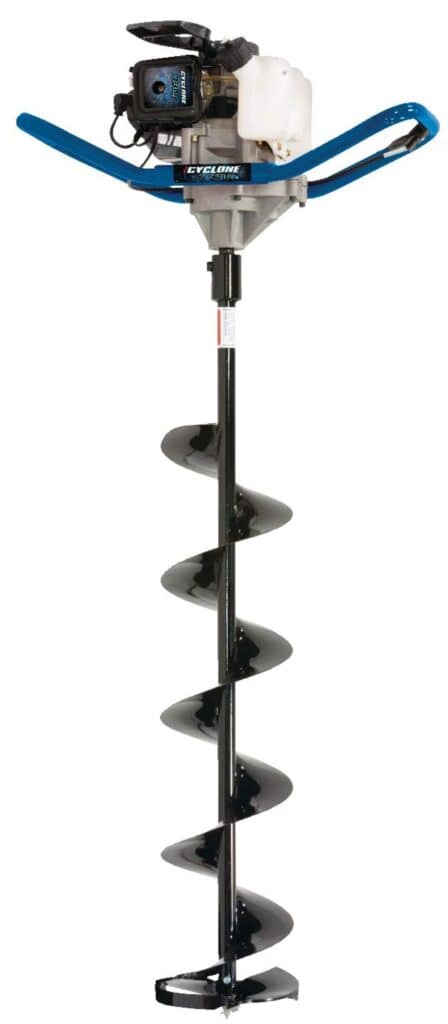
Propane Ice Augers
Propane augers offer a cleaner-burning alternative to gas-powered models, with less maintenance due to reduced fuel residue. They provide ample power, similar to gas models, but are quieter and more environmentally friendly, with no worries of contamination to the ice. Propane augers are heavier than electric ones, which can make transportation challenging but compensate with higher torque. I chose a propane auger for environmental reasons. A 1 lb. propane bottle will last me for most of the season.
Blade Types
Different augers come with flat or serrated blades. Flat blades are more durable, while serrated blades provide a quicker initial cut, which is essential for hard ice. Ensuring you have sharp blades is crucial, as dull edges require more force and wear out the motor.
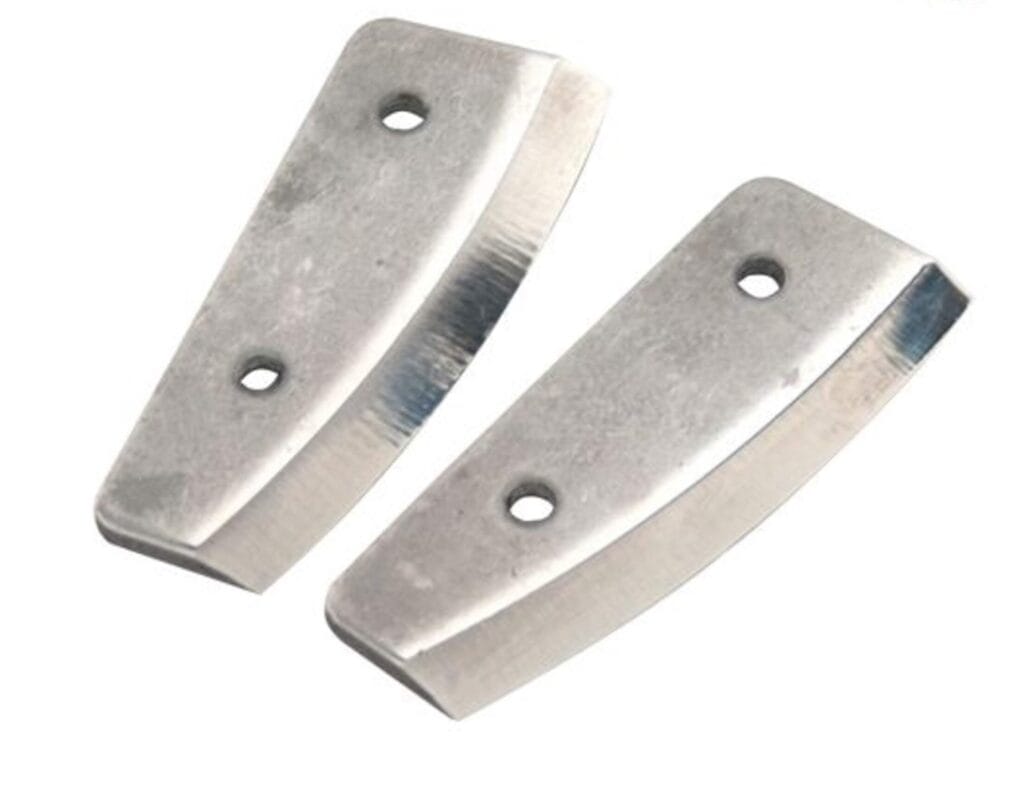
Weight and Portability
The weight of an auger impacts its portability, especially when trekking to remote fishing locations. Manual and electric augers tend to be lighter, while gas and propane augers require additional strength or transportation aids like a sled.
Power Output and Efficiency
Assessing power output is essential in gas and propane models, especially when working with thick ice. Electric augers provide a more measured power output based on battery life but may lose efficiency as the battery drains.
Choosing the Right Ice Auger for Your Needs
Ice Thickness and Auger Size
If you typically fish on thick, deep ice, a gas or propane auger is preferable. For thinner ice, manual or electric models work efficiently. Auger sizes range from 6 inches to 10 inches in diameter, and larger sizes require more power but allow for bigger fish to be pulled through the hole. I personally like a 10-inch hole when ice fishing.
Usage Frequency and Budget
For occasional ice fishing trips, a manual or small electric or drill auger may be more cost-effective. Frequent anglers who face thick ice regularly may benefit from the investment in a gas or propane-powered auger for efficiency and power.
Required Equipment for Ice Auger Use
To ensure a smooth and productive fishing experience, consider the following essential equipment:
- Spare Blades: Always bring extra blades or a sharpening tool, as ice can dull blades quickly.
- Battery Packs (for Electric Augers): Cold temperatures drain batteries, so carry spares for extended trips.
- Fuel or Propane Tanks: Extra fuel ensures you won’t run out of power mid-session.
- Ice Scoop: Useful for removing ice chips from the hole.
- Protective Gear: gloves and ice cleats so you don’t slip, as a power auger has a lot of torque.
Maintenance and Care
Regular maintenance is crucial to keep your ice auger in optimal condition. For gas and propane models, checking the fuel line, spark plug, and carburetor before each season can prevent problems. Electric augers require battery inspection and charging, especially when stored for long periods.
Keeping blades sharp is essential for all auger types. Dull blades increase effort and can damage motors, leading to costly repairs. Check the shear pin is securely in as they can loosen through use.
Troubleshooting Common Ice Auger Problems
Electric Auger Won’t Start
Check battery charge and ensure contacts are clean. In cold conditions, batteries drain quickly, so warming them up before use can extend their runtime.
Gas Auger Stalls
If the auger stalls or doesn’t maintain power, it could be a fuel issue, clogged carburetor, or dirty air filter. Cleaning and replacing these parts can often resolve the problem, but do this off the lake as you do not want to contaminate the lake with gasoline.
Difficulty Cutting Ice
Dull blades are the primary culprit when an auger struggles to cut. If replacing or sharpening blades doesn’t work, inspect the auger shaft for alignment issues, as a bent shaft can impact cutting performance.
Setting Up for Ice Fishing Success
Selecting the right ice auger, equipping it with essential accessories, and maintaining it can transform your ice fishing experience. Each type has its strengths and weaknesses, so understanding your needs will guide you to the right choice. With proper care and preparation, you’ll find that a well-maintained ice auger can last for years, making each winter fishing trip more efficient and enjoyable.
FAQ Section
Which ice auger type is the most environmentally friendly?
Electric augers are the most eco-friendly, producing no emissions, while propane models are cleaner than gas-powered options.
What is the best auger size for beginners?
An 8-inch auger is ideal for beginners, balancing hole size with ease of handling.
How often should I sharpen my ice auger blades?
Blades should be sharpened or replaced every season or after every 15-20 holes, depending on ice hardness and debris.
Can I use an electric auger in extremely cold temperatures?
Yes, but it’s crucial to monitor the battery, as cold weather drains power faster. Carrying spare batteries or keeping the main battery warm can help maintain its charge.
How do I prevent fuel from freezing in my gas auger?
Use a fuel stabilizer in the gas and store the auger in a relatively warm environment before use to prevent fuel issues.
Disclaimer: This blog post contains affiliate links

